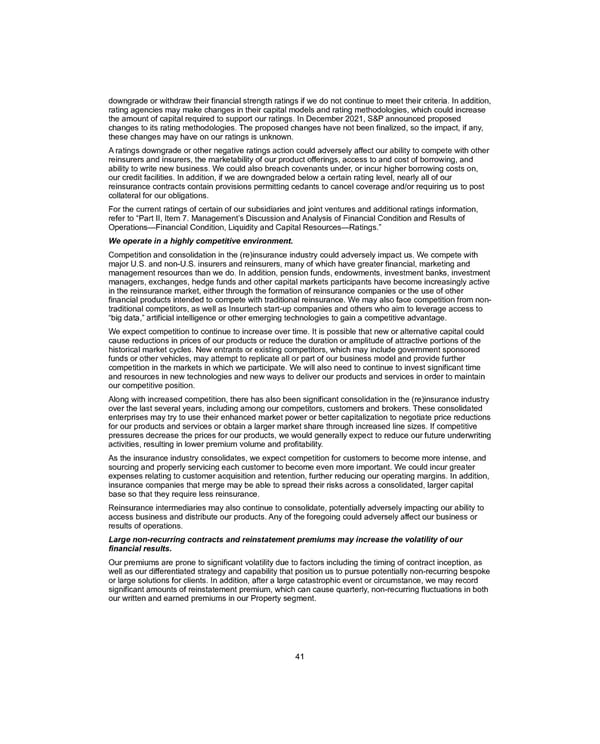downgrade or withdraw their financial strength ratings if we do not continue to meet their criteria. In addition, rating agencies may make changes in their capital models and rating methodologies, which could increase the amount of capital required to support our ratings. In December 2021, S&P announced proposed changes to its rating methodologies. The proposed changes have not been finalized, so the impact, if any, these changes may have on our ratings is unknown. A ratings downgrade or other negative ratings action could adversely affect our ability to compete with other reinsurers and insurers, the marketability of our product offerings, access to and cost of borrowing, and ability to write new business. We could also breach covenants under, or incur higher borrowing costs on, our credit facilities. In addition, if we are downgraded below a certain rating level, nearly all of our reinsurance contracts contain provisions permitting cedants to cancel coverage and/or requiring us to post collateral for our obligations. For the current ratings of certain of our subsidiaries and joint ventures and additional ratings information, refer to “Part II, Item 7. Management’s Discussion and Analysis of Financial Condition and Results of Operations—Financial Condition, Liquidity and Capital Resources—Ratings.” We operate in a highly competitive environment. Competition and consolidation in the (re)insurance industry could adversely impact us. We compete with major U.S. and non-U.S. insurers and reinsurers, many of which have greater financial, marketing and management resources than we do. In addition, pension funds, endowments, investment banks, investment managers, exchanges, hedge funds and other capital markets participants have become increasingly active in the reinsurance market, either through the formation of reinsurance companies or the use of other financial products intended to compete with traditional reinsurance. We may also face competition from non- traditional competitors, as well as Insurtech start-up companies and others who aim to leverage access to “big data,” artificial intelligence or other emerging technologies to gain a competitive advantage. We expect competition to continue to increase over time. It is possible that new or alternative capital could cause reductions in prices of our products or reduce the duration or amplitude of attractive portions of the historical market cycles. New entrants or existing competitors, which may include government sponsored funds or other vehicles, may attempt to replicate all or part of our business model and provide further competition in the markets in which we participate. We will also need to continue to invest significant time and resources in new technologies and new ways to deliver our products and services in order to maintain our competitive position. Along with increased competition, there has also been significant consolidation in the (re)insurance industry over the last several years, including among our competitors, customers and brokers. These consolidated enterprises may try to use their enhanced market power or better capitalization to negotiate price reductions for our products and services or obtain a larger market share through increased line sizes. If competitive pressures decrease the prices for our products, we would generally expect to reduce our future underwriting activities, resulting in lower premium volume and profitability. As the insurance industry consolidates, we expect competition for customers to become more intense, and sourcing and properly servicing each customer to become even more important. We could incur greater expenses relating to customer acquisition and retention, further reducing our operating margins. In addition, insurance companies that merge may be able to spread their risks across a consolidated, larger capital base so that they require less reinsurance. Reinsurance intermediaries may also continue to consolidate, potentially adversely impacting our ability to access business and distribute our products. Any of the foregoing could adversely affect our business or results of operations. Large non-recurring contracts and reinstatement premiums may increase the volatility of our financial results. Our premiums are prone to significant volatility due to factors including the timing of contract inception, as well as our differentiated strategy and capability that position us to pursue potentially non-recurring bespoke or large solutions for clients. In addition, after a large catastrophic event or circumstance, we may record significant amounts of reinstatement premium, which can cause quarterly, non-recurring fluctuations in both our written and earned premiums in our Property segment . 41
 2021 Annual Report Page 56 Page 58
2021 Annual Report Page 56 Page 58